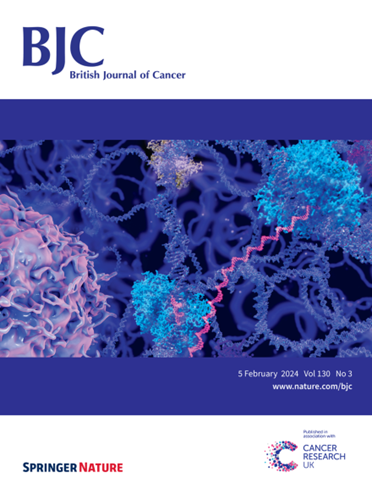Stroma AReactive Invasion Front Areas (SARIFA), tumour immune microenvironment, and survival in colorectal cancer
IF 6.4
1区 医学
Q1 ONCOLOGY
引用次数: 0
Abstract
SARIFA (Stroma AReactive Invasion Front Areas), defined as the direct contact between a tumour cell cluster and adipose cells at the invasion margin, has been proposed as a prognostic marker in gastrointestinal cancers. We hypothesized that SARIFA is associated with an immunosuppressive tumour microenvironment. SARIFA status was evaluated in two large colorectal cancer cohorts (N = 1876). Survival analyses were performed using multivariable Cox regression. Immune cell densities were analysed utilizing multiplex and conventional immunohistochemistry combined with digital image analysis. SARIFA-positivity was independently associated with a shorter cancer-specific survival in both cohorts [Cohort 1: hazard ratio (HR) for SARIFA-positive (vs. negative) 1.75 (95% CI 1.35–2.25), P < 0.0001; Cohort 2: HR for SARIFA-positive (vs. negative) 2.09 (95% CI 1.43–3.05), P = 0.0001]. SARIFA-positivity was associated with lower densities of CD3+ T cells, CD66b+ granulocytes, M1-like macrophages, and CD14+HLA-DR+ mature monocytic cells, but higher densities of M2-like macrophages and CD14+HLA-DR- immature monocytic cells. Mean Cohen’s kappa for SARIFA evaluation between eight investigators was 0.80. SARIFA status is a highly reproducible, independent prognostic factor in colorectal cancer. SARIFA-positivity is associated with lower densities of antitumourigenic immune cells and the polarisation of macrophages towards a protumourigenic M2-like phenotype.

基质反应性侵袭前区(SARIFA)、肿瘤免疫微环境与结直肠癌的生存。
背景:SARIFA(基质反应性侵前区)被定义为肿瘤细胞簇与脂肪细胞在侵前边缘的直接接触,已被提出作为胃肠道癌症的预后标志物。我们假设SARIFA与免疫抑制肿瘤微环境有关。方法:在两个大型结直肠癌队列(N = 1876)中评估SARIFA状态。采用多变量Cox回归进行生存分析。免疫细胞密度分析利用多元和传统的免疫组织化学结合数字图像分析。结果:sarifa阳性与两个队列中较短的癌症特异性生存期独立相关[队列1:sarifa阳性(vs.阴性)的风险比(HR)为1.75 (95% CI 1.35-2.25), P + T细胞,CD66b+粒细胞,m1样巨噬细胞和CD14+HLA-DR+成熟单核细胞,但m2样巨噬细胞和CD14+HLA-DR-未成熟单核细胞的密度更高。8位研究者SARIFA评估的平均Cohen kappa为0.80。结论:SARIFA状态在结直肠癌中是一个高度可重复性的独立预后因素。sarifa阳性与低密度的抗肿瘤免疫细胞和巨噬细胞向致肿瘤的m2样表型极化有关。
本文章由计算机程序翻译,如有差异,请以英文原文为准。
求助全文
约1分钟内获得全文
求助全文
来源期刊

British Journal of Cancer
医学-肿瘤学
CiteScore
15.10
自引率
1.10%
发文量
383
审稿时长
6 months
期刊介绍:
The British Journal of Cancer is one of the most-cited general cancer journals, publishing significant advances in translational and clinical cancer research.It also publishes high-quality reviews and thought-provoking comment on all aspects of cancer prevention,diagnosis and treatment.
 求助内容:
求助内容: 应助结果提醒方式:
应助结果提醒方式:


